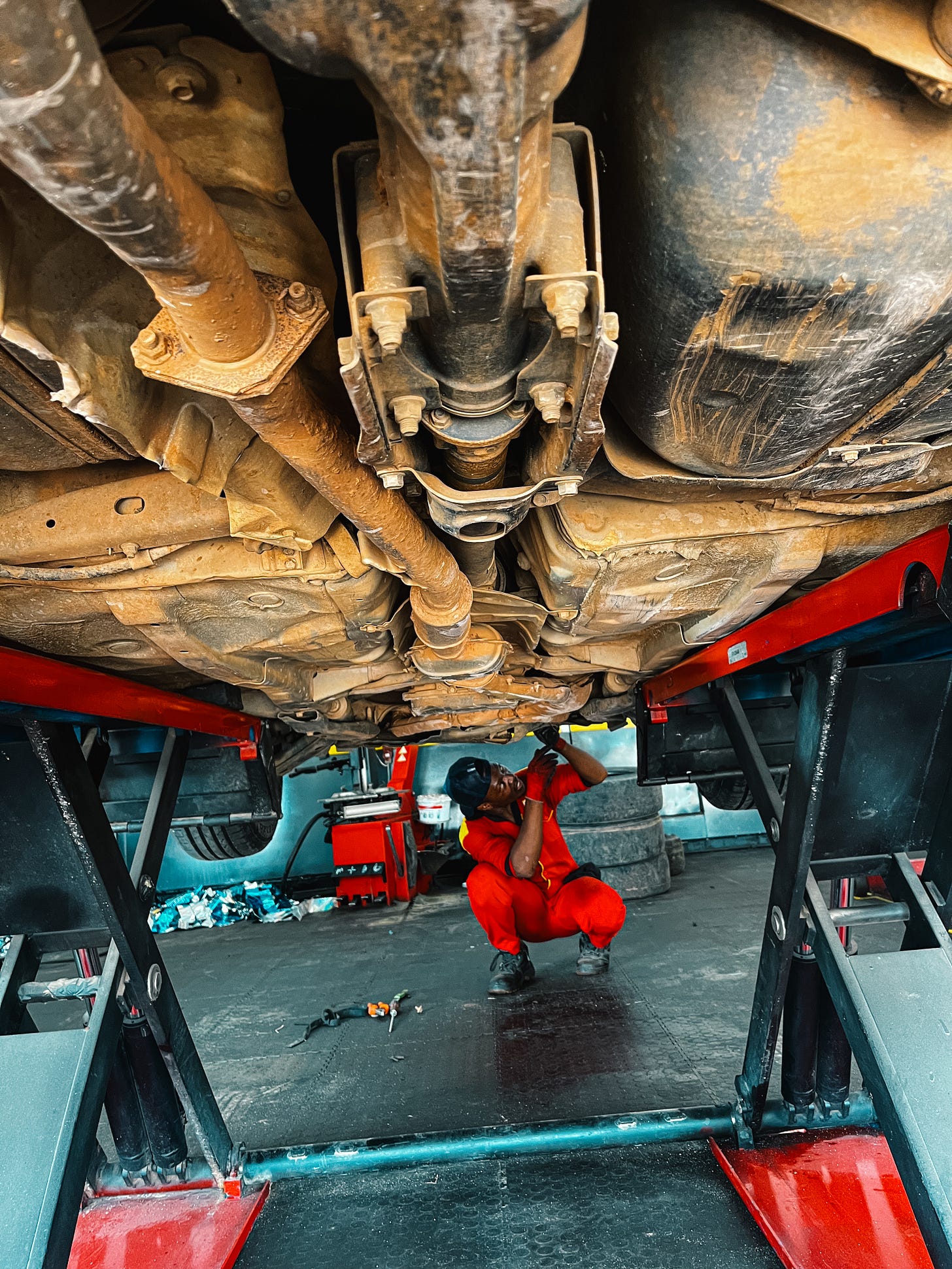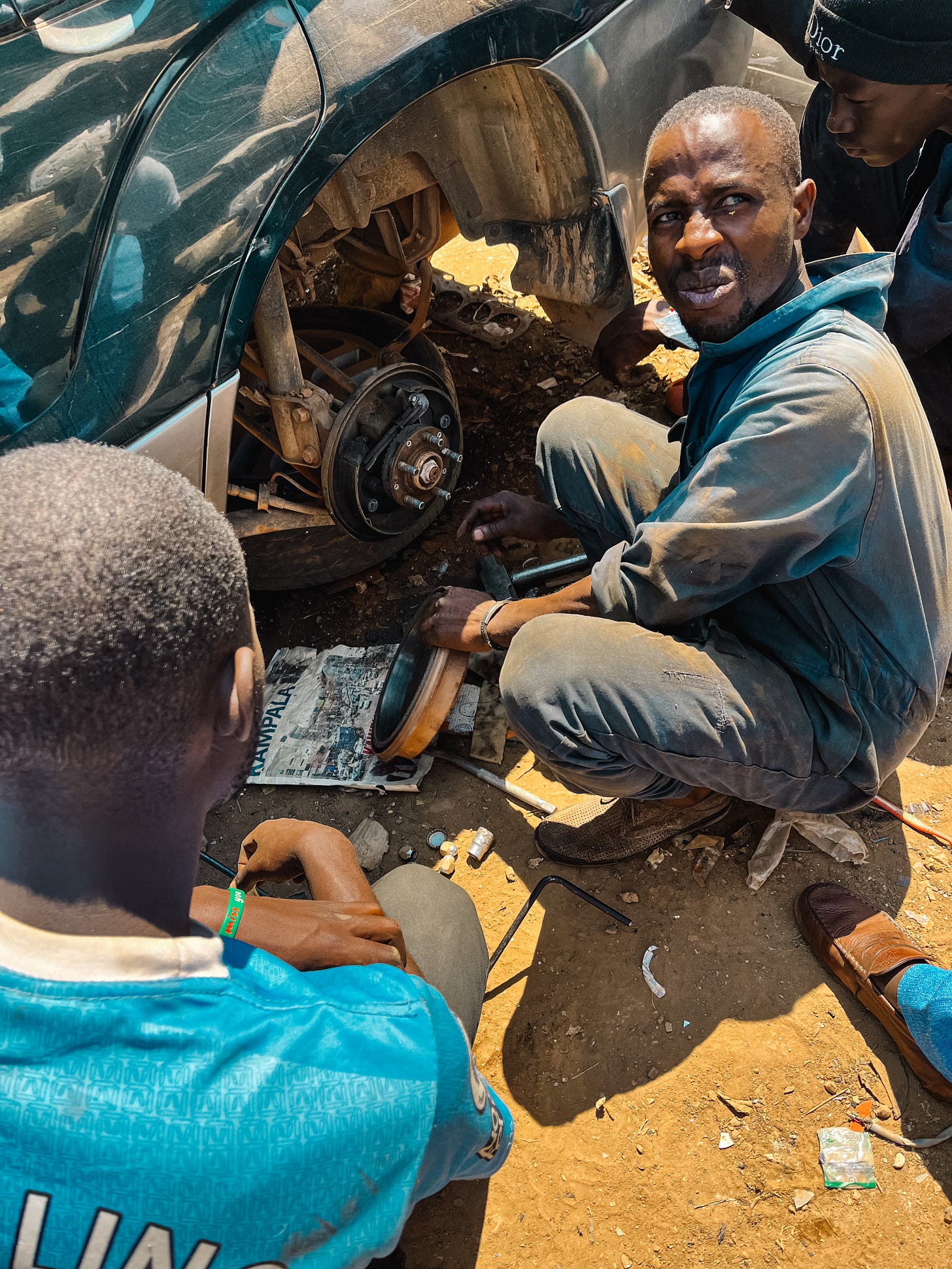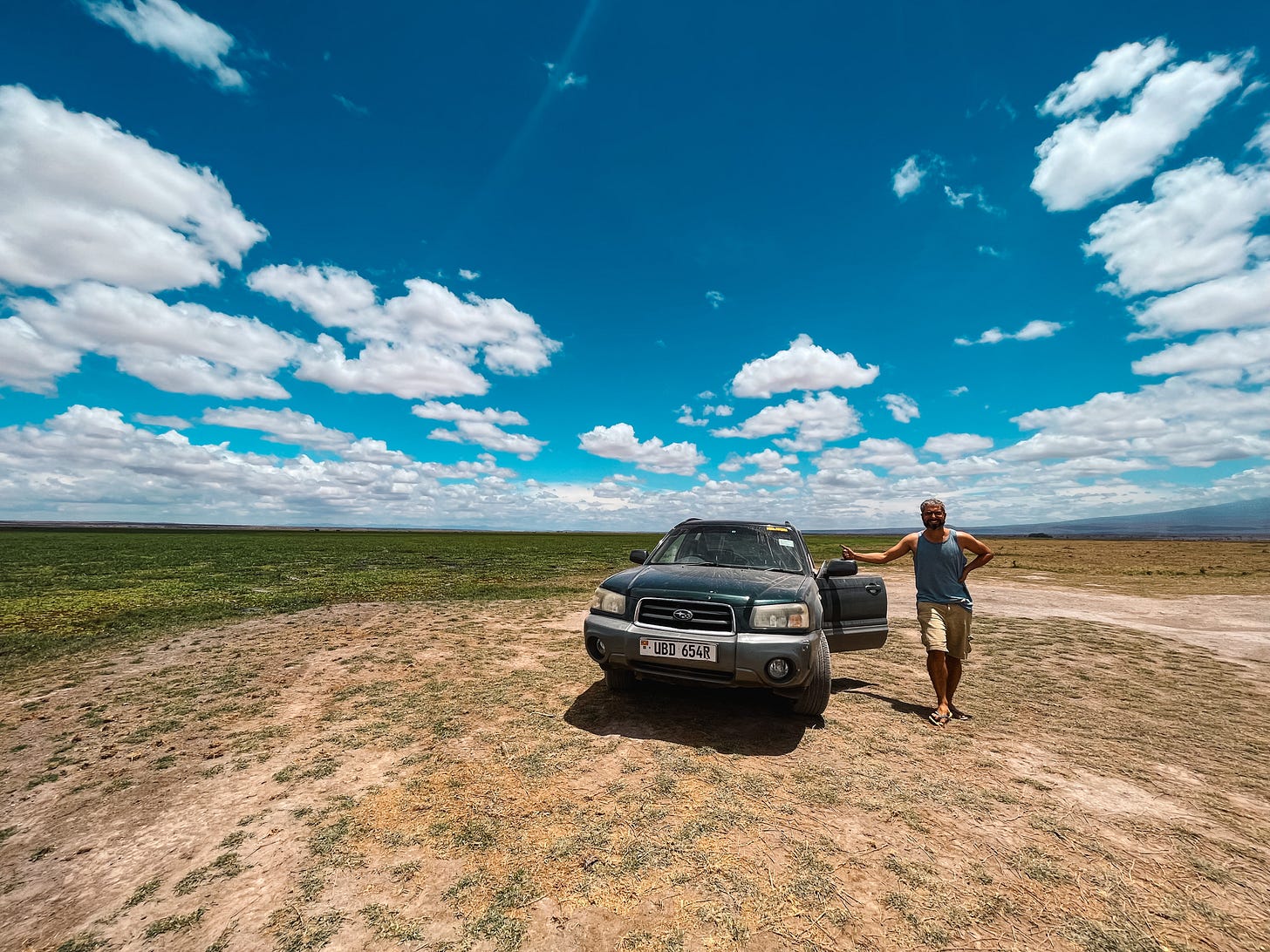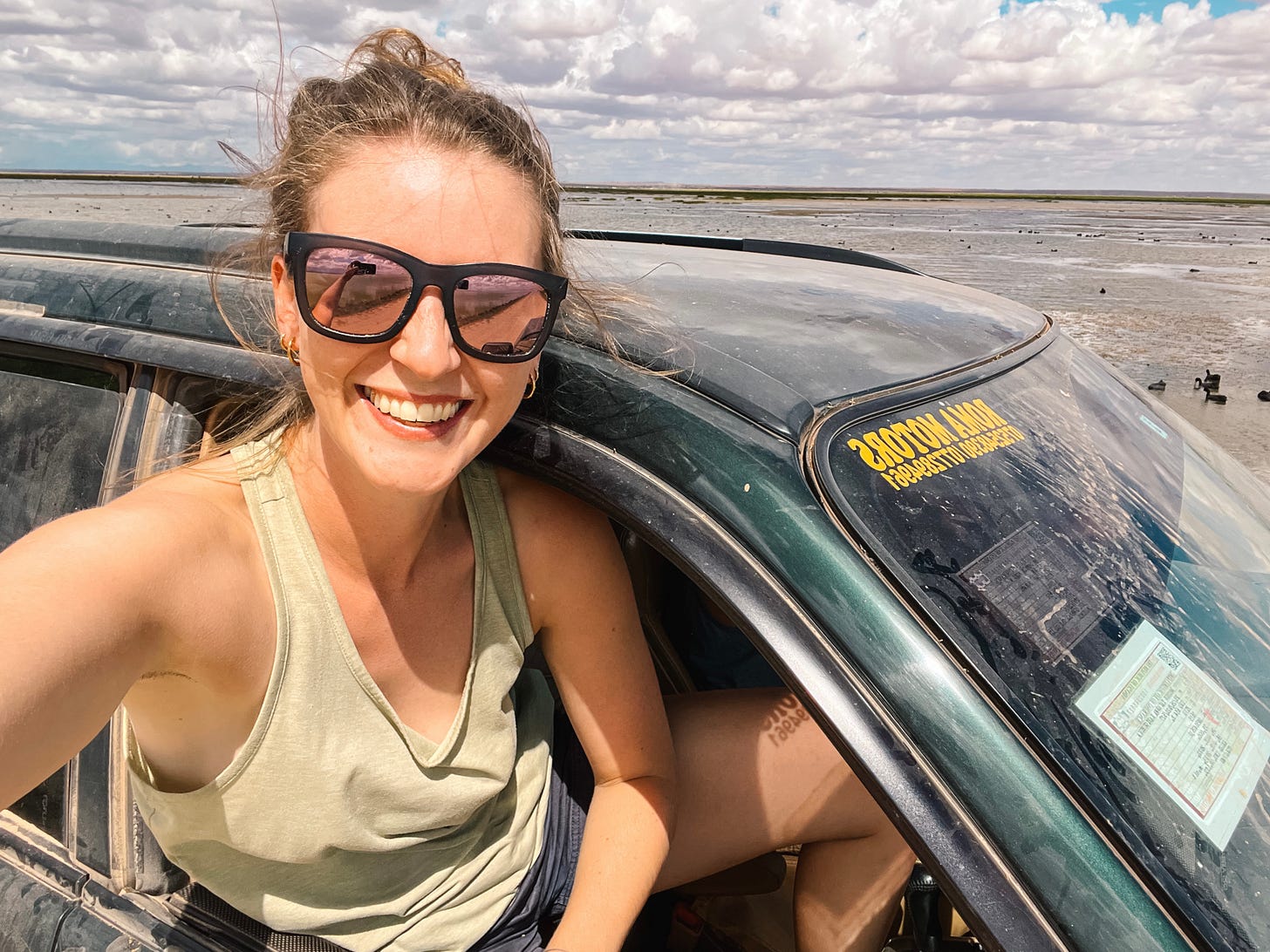It’s nearly half a year since we’ve been on the road now. 8000 kilometres later, and it’s safe to say that we’ve learned a lot. We wanted to share a few stories about our experiences driving in East Africa in our trusty 20 year old Subaru Forester. We bought the car in Uganda, as you might already know, which was an adventure in itself before even hitting the road (in case you have forgotten or not seen the post yet, click here). Even though brand new cars are still rare, in Uganda they consider the second-hand Japanese imports as new - new to the African roads is the real definition. And once they arrive in Africa, they really get to prove what they are made of. We always joke about our poor Subaru, and how she started her life on the perfectly paved roads of Japan, only to live out her adult years on the potholed, and partially flooded (rainy season) dirt roads of Africa.
Our driving journey began in Uganda, which in retrospect is probably one of the more challenging places on the continent to start your African driving experience. In the countryside of Mbarara, our base for the first two months, we slowly got used to the dusty dirt roads, as well as the surprise potholes on the tar roads. Luckily the traffic in that region was still manageable, and it was only during our regular trip to Mbarara town centre where we had to start fighting for our corner on the tarmac. It also didn’t take us long to realise that driving at night is a no-go, mostly because of the dangerous potholes, as well as other drivers who seem to believe that their vehicle cannot be driven without full headlights on. It makes for a fairly nerve wrecking experience…
Rwanda was one of the first roadtrips with our car. It’s an interesting country in terms of driving, and it seems it could be the country with the most speeding cameras in the world. It’s one of the first things you notice when you cross the border from Uganda into Rwanda. Apart from the almost perfect roads and sidewalks, you will see a fixed speeding camera every few hundred metres. The overall speed limit in Rwanda is 60km/h, which was not a problem for us, as in the beginning we didn’t dare to go much over 60 km/h, not knowing if our 20 year old car would fall apart at the next speed bump. As we explored the highlands of Rwanda, expecting the road to remain as perfect as it was, we faced what remains to this day the worst road we’ve driven yet. 6 hours of rough bumpy roads where we constantly expected a flat tyre or the car to break down at any second. After surviving the stress of the 6 hours ride from hell we finally reached our campsite, but upon entering down a small rocky road, the car started to make funny noises - it was very clear that something was wrong. We were worried at first, given that we were in quite a remote area, and not knowing if there would be a possibility to have the car fixed. But in Africa there is always a solution. After two quick phone calls, a mechanic was organised for the next morning. He quickly identified our very first car issue: a broken gear shaft. Given our distance from a garage, the necessary spare parts were not available, but the mechanic told us not to worry. A piece of old cloth and a full tin of grease later, our Subaru was running better than ever. We drove about 1000 kilometres with the improvised solution, until we were able to properly service and fix the car in Kampala, the only place in Uganda where something close to a semi-offical Subaru representative can be found.
I have to say that after driving the many challenging roads, and seeing the harsh conditions that vehicles are exposed to here, I am more impressed than ever by the durability of cars. Having been super happy with our Hyundai i30 back in Switzerland, and having had a Toyota Yaris as my first car, I’ve always appreciated Asian cars. Asian car brands are extremely prominent here in Africa, with Toyota (a 64% market share in Uganda) at the top of the list, followed by Nissan, Subaru, Isuzu and Ford. The key selling point of Asian cars is the durability as well as repairability factor, which we quickly learned is crucial when cruising around African countries. The conditions cars are exposed to are extreme. Even when driving carefully it’s not always possible to avoid pot-holes, especially when oncoming traffic takes up most of the road and allows you no space to avoid a crater, leaving you with no other option than to bite the bullet and hope that your axes don’t break while you fly over it. On top of that, the extreme heat and the dust entering every single crack of the car takes its toll. Despite all these external factors out to destroy our car, it just shows how durable the old Subaru really is.
Of course other minor repairs followed the broken gear shaft, and it’s safe to say that each injury leads to a small adventure. The garages are normally open air and very improvised, to the extent that you don’t even realise it’s a garage at first, as it looks more like a graveyard for vehicles and spare parts. The “garages” are also normally not specific to a single car brand, they are universal, and there will always be a mechanic that can take care of your car’s issue, nevermind the age and model. Professional car lifts, the ones where the entire car can be lifted into the air, are still rare. Here it is normal to have a trench or a hole in the ground, or it is done fully manually with your own car jack. It is definitely one of the harder jobs in this world, because using a car jack repeatedly, lifting the car onto stones on several or all sides, in a 30+ degrees open air environment, usually leads to a waterfall of sweat.
The mechanics and the spare part dealers are usually independent of each other. Once a problem is identified it doesn’t take long before the spare parts dealer from up the road is standing next to you with the exact spare part needed. You haggle a bit, agree on the price, purchase it, and then hand it over to the mechanic to install. Of course you also haggle the repair price, as there will always be the Mzungu penalty thrown in, but soda money is always deserved when you see how fast they can repair the car with such basic tools and infrastructure.

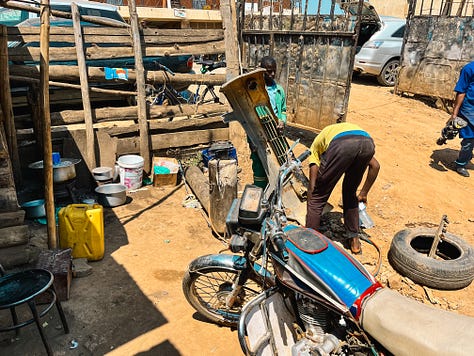



Of course the good thing with having a 20 year old car is that you don’t really tend to worry about collecting new scratches and bumps. You can imagine our confusion when someone approached us and told us that he had scratched off our car while he was parking his own. We were more concerned about his car, and would never have noticed the new addition to ours had he not informed us. We had to laugh about it in the end, imagining how that whole situation would have played out if it happened in Switzerland…
Probably the least pleasant encounter we’ve had with our car happened in a mangrove forest in the middle of nowhere. When we returned to our car after a night of camping, we realised that we had acquired a little passenger who had helped himself to a feast of food, basket, and carpet during the night. As we often cook for ourselves along the way, we always have some food and supplies in the car, which obviously attracted the intruder. We are not sure how the (presumed) mouse managed to get inside the car, but by following the trail of pieces of plastic, food, textile and cardboard, we could establish that he ate his way from the back to the front of the car, and it seems he even ate his way out. We could never fully prove whether he remains to be a passenger or not, or if he died from overeating, but we presume he would not survive very long in the heat of the car in the hot sun. The company was nice while it lasted…

Police encounters are very common on the road. In some parts they could have road blocks every 30 minutes or so. Of course being two Muzungus with a Ugandan licence plate means that we are always stopped, almost without exception. It’s often assumed by Europeans that bribery is rampant in Africa, especially when dealing with police, but it’s really not as bad as you might think. Of course you are often asked for some “support”, so-called “soda money” or a “goodie goodie” when you are stopped, but we quickly realised after a few stops that they’re only asking, and you can easily say no. While in the beginning we “donated” a bit of food to several police officers - believe it or not we have literally paid bribes with instant noodles - we got more strict and stuck more to the small talk, until they would realise that they won’t be getting anything out of these two scabby Muzungus. Of course it’s not about the money, we would just prefer to avoid promoting corruption. On the other hand, in many cases we felt sorry for the policemen and women, as they were standing outside for the whole day in extreme heat, in sometimes very remote locations, and who can blame them for trying to earn a few extra bucks for their hardship.
We don’t always get off scot free with the police, we have of course encountered fines - some justified, some absolutely not. When it has been justified, we would always say that we are happy to pay, but that we would only pay if they issue us with an official ticket. Turns out that the fine is not always their real intention, as probably 99% of the fines they “issue” are settled with a small bribe. In the end they usually send us on our way, the last thing they want to deal with is the admin associated with issuing a fine to a foreign vehicle… That is until we met the diligent police of Tanzania, and until Emma possibly mistook the gas for the brake pedal, and was caught during a speeding control (in her defence, it was a very sneaky one). The official fine for 5 km/h over the limit is TSZ 30’000 / CHF 12, but interestingly enough it doesn’t matter how much over limit you are. Whether you drive 5 km/h too fast, or 50 km/h too fast, or drive over a red light or a security line, the fine is always the same. Long story short, if you are speeding, do it right! And as if one speeding fine was not good enough for Emma that day, she got another one ten minutes later. Funnily enough she managed to get herself out of paying that one by telling the police officer that she had paid a speeding ticket a few minutes earlier, showing him the receipt, and complaining that she had already spent enough money on speeding fines that day. Luckily he agreed, and sent us off on our merry way with just a scolding.
We are positively surprised about the ease of travelling across borders. Having heard horror stories about massive bribes and kilometre long traffic jams at borders in the horrible heat, we expected the worst. In reality it turned out to be rather relaxed so far. However we do our research in terms of necessary documents (e.g. insurances) and also regarding the locations we choose to cross into a new country. We tend to choose small and less busy border crossings, and the Dutch app/website iOverlander proves to be useful, as fellow travellers can share their experiences and give tips. An interesting phenomenon is that at each border crossing you can find the so-called “fixers”, who are eagerly awaiting their prey - the Muzungus. They are not officially working for the customs or border staff, but they do try to make a bit of money while “guiding” you through the process. In reality it’s not really necessary, but it definitely accelerates the crossings, as they tend to know some people, and also the places you need to go. It can also be annoying as they are VERY persistent and would stick to you even if you don’t ask for their services. So the best strategy is to choose one that seems sympathetic, and let him help you in exchange for a few dollars.
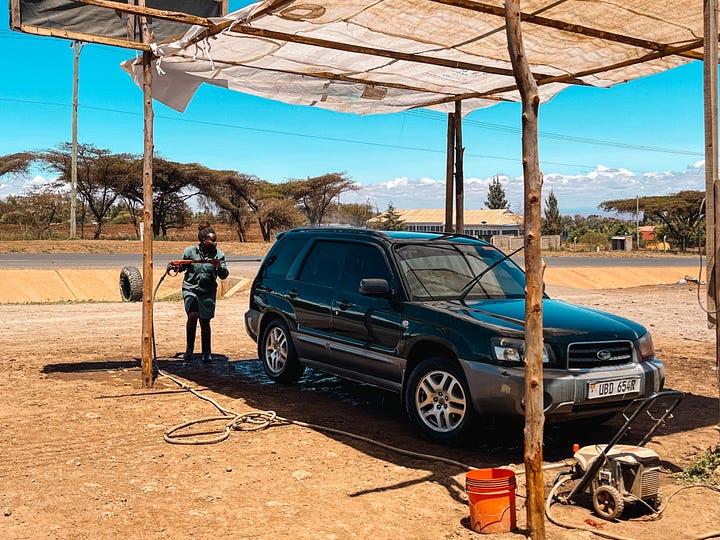
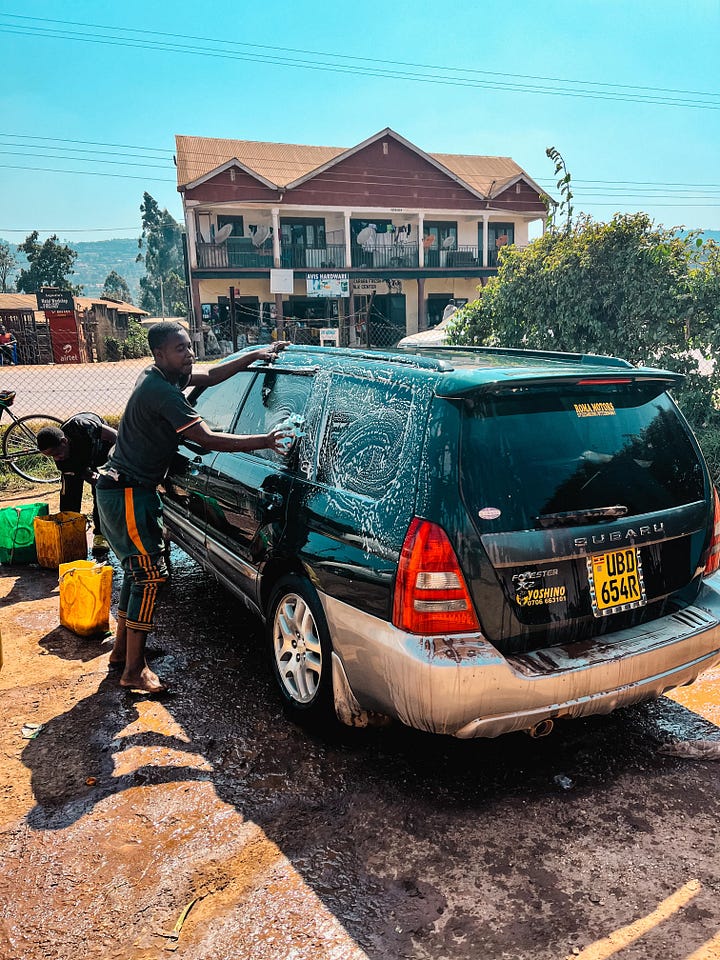
In hindsight, buying the Subaru was one of the best decisions of our trip. In the beginning we briefly considered travelling by public transport. For sure it would have been a great adventure, however after seeing the driving style of the public buses, we are glad to have our safety, at least to a certain extent, in our own hands. We also value the flexibility we have with the car, to be able to stop and go anywhere is a great asset. We would definitely recommend getting your own car if you you are planning a longer trip in East Africa. There are also very good rental options available, like the company www.roadtripafrica.com. Or contact us in a few months and we might sell it to you at a good price…
In conclusion, driving in Africa is relatively chilled as long as you are driving the rural roads, apart from having to constantly avoid goats, chicken, dogs, snakes and cows. As soon as you go into big towns and cities, the madness begins. The immense amount of people, combined with boda-boda’s, tuk-tuks, and buses, makes it very challenging to drive. You need to have a good balance of being alert enough to not crash into anything, and being persistent enough to move forward. Never try to insist on the law, especially with the truck and bus drivers. The most important takeaway here is: size matters, and the bigger always wins.








